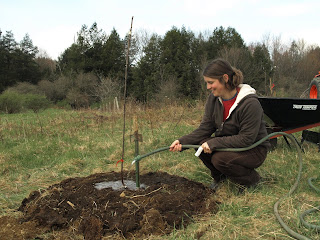Today we planted 34 apple trees, though we've been working on it all week. Almost as important, we had planned on putting up a fence to protect them from the deer that roam all over our fields. Though they don't populate these parts as densely as some suburbs, and so might go after the planting less voraciously, our chosen orchard site has enough hoof-trod paths and pebble-like scat to make a good protection plan prudent.
The trees came on Friday, shipped UPS in a 4' box with a sort of plastic swaddling to keep their roots moist.

On Tuesday I went up and cleared the brush we had cut this winter, while Ed fixed a 20-year-old weed-whacker. After lunch he went up to mow the future fence line, while I used the tractor to fill the pickup with some of the beautifully rotted manure that is piled up about the property. I then attempted to drive this to the site, but I bogged down. I pulled the truck out with the tractor and tried again, and again I failed. Once more I dragged the truck out and backed it down in defeat.
Of course, those three sentences took hours to unfold, and by the time I had taken the tractor and some lime and tools up the hill, the afternoon was waning. Ed grabbed a shovel and I grabbed another. He put his to the earth and pushed down with his heel, but the blade only cut a few inches before stopping dead. I tried with the same result, and I could feel the metal scraping against rock. We laboriously cleared a circle the size we thought we needed. The ground seemed to be three quarters rock and one quarter dirt.
"Maybe we should use the backhoe," said Ed, and I nodded. He went and worked on building shelves in the barn, and I went and dumped the manure on the garden.

Wednesday morning we got up. I won't speak for Ed, but I was optimistic. Out in the hops barn where we park the tractor, we also have a backhoe attachment. As these things always seem to, it took longer than expected to get everything hooked up, and longer still to figure out how to engage our tractor's hydraulics. But it wasn't too late in the morning when we pulled out, certain that we now had the advantage. That's when Ed noticed the hydraulic fluid dribbling down from beneath the controls.
"Maybe it's just a loose fitting," I said. I removed the metal plate from the front of the backhoe. It was definitely the hose itself that was dripping, not the fitting. (To be clear, the tractor was off, so there was no possibility of pressure coming through the line.)
We resigned ourselves to a tough day of work and trudged up the hill. But to our surprise the hole we had dug the previous day was aberrant - just fifteen feet down the slope we hit much less gravel, and and in a few minutes we had readied a second circle. Normandy came up and helped, and by midway through the afternoon we had the holes all dug.
Perhaps the ground had dried out more, or perhaps Ed moonlights as a monster truck driver. Either way, he succeeded where I had failed, and suddenly we had everything we needed to plant.

Thursday (Earth Day as it so happens) all four of us set about planting, driving stakes and mounding the soil around the roots. Because the trees were grafted - the rootstock determines the ultimate size - we had to make sure to keep the union above the soil level.
There has been one more setback. I left a message for the guy who had supposedly been making our fence posts all week, just to confirm that I could pick them up the next morning. His wife had called on Tuesday and asked if we could wait an extra day on them, since her husband's partner was in the hospital. But sometime in the past few days they had decided that they could not actually make the posts but had seen no reason to call and tell us this. So if anyone knows where to get some locust fence posts, preferably in central New York, let us know.

But the trees look good for now, and hopefully we will figure something out before the deer find the orchard.
We planted eight types of trees, some for eating, some for cider, and some for both.
This is just a picture of me on our awesome tractor.
-Garth





















